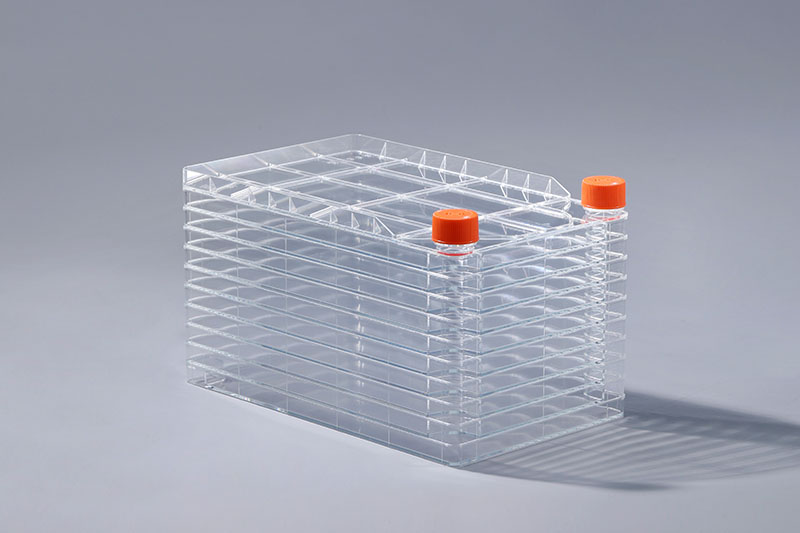Mae datblygiad cyflym y maes gwyddorau bywyd wedi parhau i ehangu'r galw am nwyddau traul diwylliant celloedd. Yn eu plith, mae llawer o gwmnïau fferyllol a gweithgynhyrchwyr brechlyn yn ffafrio Nid yw tymheredd uchel yn dda ar gyfer diwylliant celloedd. Os caiff y celloedd eu meithrin ar 39 ~ 40 ° C am 1 awr, byddant yn cael eu difrodi i raddau, ond gallant wella o hyd, ond ni allant oddef cynnydd tymheredd o 2 ° C am sawl awr. Mae'r llawdriniaeth yn ddifrifol, ac mae'r rhan fwyaf o'r celloedd yn cael eu lladd pan fydd y tymheredd yn uwch na 43 ° C. Mae tymheredd uchel yn bennaf yn achosi anactifadu ensymau, dinistrio lipidoidau, dinistrio rhaniad niwclear, cynhyrchu coagulase, ceulo celloedd, a dadnatureiddio proteinau. Felly, rhaid osgoi tymheredd uchel wrth feithrin celloedd in vitro. Wrth ddefnyddio ffatrïoedd celloedd ar gyfer diwylliant celloedd, defnyddir deorydd tymheredd cyson neu dŷ gwydr i sicrhau bod y celloedd bob amser ar dymheredd addas a chynnal cyflwr twf da. ar gyfer diwylliant celloedd ar raddfa fawr. Mae twf celloedd yn gofyn am rai amodau, yn ogystal ag amgylchedd di-haint, mae hefyd angen tymheredd addas. Bydd tymheredd amgylchynol anaddas yn effeithio ar dwf celloedd. Mae goddefgarwch celloedd i dymheredd isel yn gryfach na thymheredd uchel. Ar dymheredd isel, mae gweithgaredd metabolig a chynhwysedd mitotig celloedd yn cael eu lleihau. Os nad yw'r tymheredd yn is na 0 ° C, er bod metaboledd y gell yn cael ei effeithio, nid oes unrhyw ddifrod; ar 25 i 35 ° C, mae'r celloedd yn tyfu ar gyfradd araf.
Dim ond un o'r amodau sylfaenol ar gyfer meithrin celloedd yw tymheredd priodol.
. Yn ogystal, mae angen amgylchedd di-haint, pwysedd osmotig, amgylchedd nwy a pH. Bydd unrhyw fethiant i gwrdd â'r safon yn effeithio ar y broses o ddiwylliant celloedd.
cell ffatrïoeddcell factories. In addition, sterile environment, osmotic pressure, gas environment and pH are required. Any failure to meet the standard will affect the process of cell culture.
The FAI climbed 5.9 percent year-on-year in the first 11 months of 2018, quickening from the 5.7-percent growth in Jan-Oct, the National Bureau of Statistics (NBS) said Friday in an online statement.
The key indicator of investment, dubbed a major growth driver, hit the bottom in August and has since started to rebound steadily.
In the face of emerging economic challenges home and abroad, China has stepped up efforts to stabilize investment, in particular rolling out measures to motivate private investors and channel funds into infrastructure.
Friday's data showed private investment, accounting for more than 60 percent of the total FAI, expanded by a brisk 8.7 percent.
NBS spokesperson Mao Shengyong said funds into weak economic links registered rapid increases as investment in environmental protection and agriculture jumped 42 percent and 12.5 percent respectively, much faster than the average.
In breakdown, investment in high-tech and equipment manufacturing remained vigorous with 16.1-percent and 11.6-percent increases respectively in the first 11 months. Infrastructure investment gained 3.7 percent, staying flat. Investment in property development rose 9.7 percent, also unchanged.
 English
English



















































